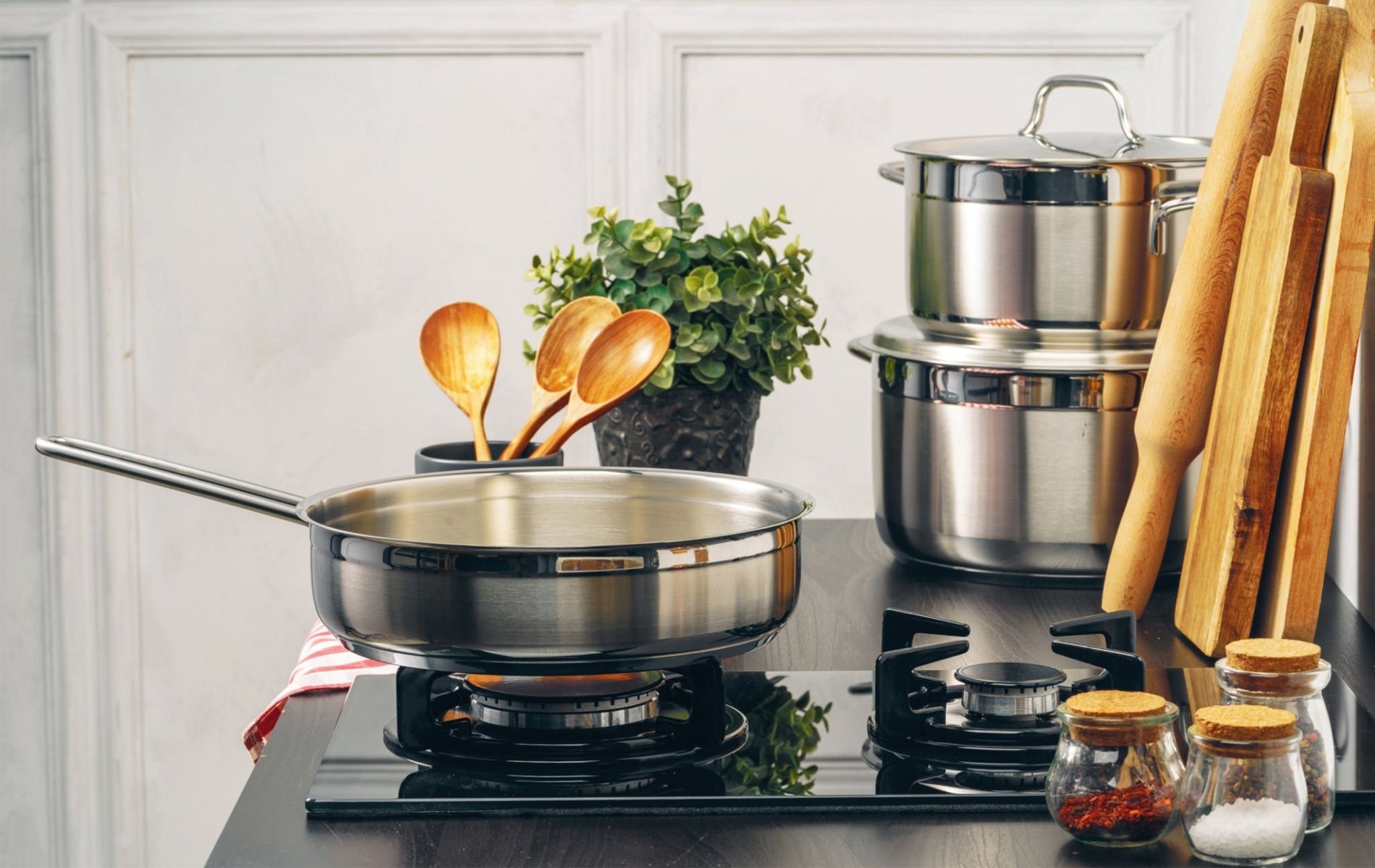How To Clean Stainless Steel Cookware
The arrival of a new set of stainless steel cookware is a joyful occasion. The second you lay eyes on it—all shiny and pristine—you’re already dreaming of all the searing, caramelizing, and sautéing you’ll be doing. But in the same breath, you also think: Man, I really hope I don’t ruin this gleaming piece of perfection. Because as much as stainless steel pots and pans conduct, distribute, and maintain heat beautifully, and are an absolute joy to have around the kitchen, they also need your care and attention.
Let’s take a closer look at how to give your stainless steel cookware the care and attention it deserves.
How to Clean Stainless Steel Cookware

- Create a Cleaning Solution
Fill a sink or dishpan with hot water and add a few drops of a good dishwashing liquid, preferably one with a degreaser as one of the main ingredients.
- Scrape Away Excess Food
Use a wooden spatula to scrape away excess food left on the stainless steel cookware. Dispose of the food properly.
- Wash the Cookware
Submerge the cooled cookware in hot soapy water. Use a non-abrasive sponge to wash the inside and outside of the cookware.
- Rinse and Dry
Once the cookware is clean, rinse well with warm water. Immediately use a microfiber towel to dry the cookware thoroughly. This will help prevent water spots and streaks.
Daily Care and Use
There is more to caring for your cookware than just washing it. So, if you find joy in cooking, then there is a good chance you are standing over your kitchen range quite often. Knowing a few best practices, if you will, can mean the difference between having stainless steel cookware that lasts you for years to come – and having to routinely invest in a new set.
Let your pans heat up slowly. You never want to place your cold stainless steel pan on a burner with high heat. Instead, heat the pan up slowly. When you have a good quality set with this finish, know that it holds heat. If you start off too high, you could risk burning your food.
Allow cold foods to warm up. When you put cold or frozen foods into a hot stainless steel skillet, they are likely to stick to the surface. The reason for this is that the metal contracts with cold. Before you begin cooking, make it a routine to allow your foods to sit out on the counter for about 10 or 15 minutes so that they are not too cold.
Heat your pan, then add oil. If you don’t want your food to stick to your stainless steel cookware, then let it heat up before you add your oil. Doing so will give you a nonstick surface to work with.
Boil first, then salt. Adding salt to pasta as it cooks can help prevent it from sticking together. It isn’t uncommon to fill a pan with water, throw in some salt, and put it on to boil. However, you do not want to do this with stainless steel. Allowing salt to settle on the bottom of the pan before boiling can leave marks, and a type of corrosion may occur. And just because you cannot see it doesn’t mean it isn’t there. Always get your water boiling and then add the salt.

Addressing Issues with Your Stainless Steel Cookware
For cleaning chalky white spots (which can result from calcium buildup in the water): Bring a solution of vinegar and water (think 1:3) to a boil in the pan, let it cool, and then wash and dry as normal.
For general buildup: Fill the pan with hot soapy water, and let sit a few hours, before scrubbing with a non-abrasive sponge.
For stuck-on food bits: Scrub the pot with a non-abrasive sponge to get off any food bits you can, then fill the pot or pan with enough soapy water to cover the food, bring to a boil, and scrape (the food should come away easily). You can also do this by replacing soap with a couple spoons of baking soda. Bring it to boil (but watch closely, as it will bubble up), and then reduce it to a simmer. Using a wooden spoon, scrape off the bits of food, which should come off pretty easily. Once you're pleased with the results, turn it off and let it cool (but don't let it get totally cold). Take it to the sink and use a long-handled brush or scouring pad to scrub off your mess (but don't forget to dry immediately!).
For discoloration (often rainbow in appearance), which can occur from overheating: fret not, for a solution is well in sight. Here's what you do: Splash a little white vinegar diluted with water into your pan, swirl the mixture around, and use a non-abrasive sponge to wipe away the rainbow stains. Vinegar's acidity will help break down that thin oxidized rainbow layer while still being gentle on your pans. Rinse, dry, and...voila! Your stainless steel will be gleaming good as new.
Investing in Kitchen Appliances
If you currently have stainless steel cookware – or you are considering making the investment – hopefully, these tips on how to clean stainless steel cookware can help you make the most of it. But before we go, we thought we should mention just how well this cookware will go with appliances by Thermomate. Can you picture it? A stainless steel pan on your induction cooktop. It’s a beautiful sight.
Together, the timeless shine will last a long time – and through all your decor changes, too.

